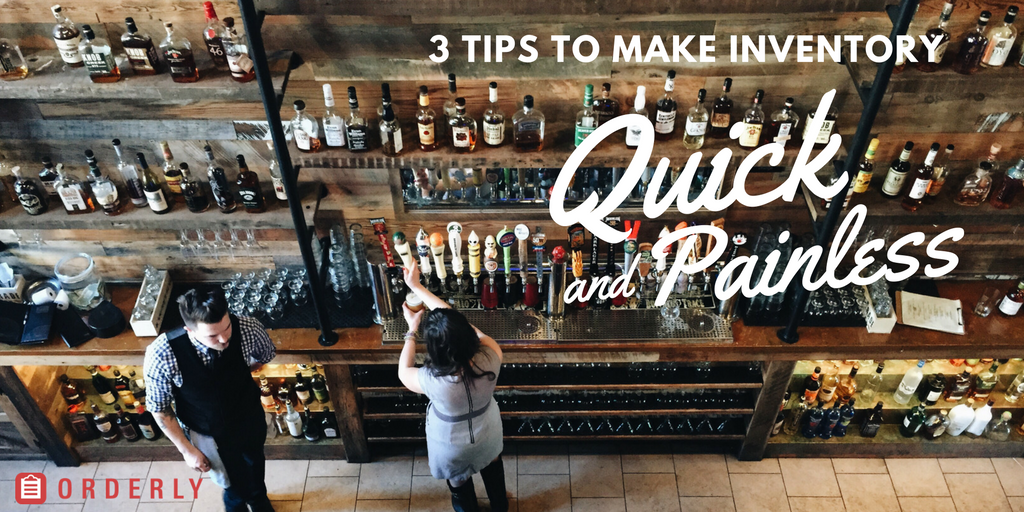Taking the Dread Out of the Inventory Process
7 Min Read By Joy Ugi
Let’s face it: restaurant inventory management is not what lured you into the business.
But are you allowing inventory to be more painful than it needs to be?
Maybe this is familiar… “OK, team,” you begin in a cheerful and hopeful tone. “Who wants to volunteer to do restaurant inventory?”
And, perhaps unsurprisingly, your query is met with oppressive silence and lack of direct eye contact.
Typically, restaurants allocate between 25 – 35 percent of its operating budget to purchasing food. Proper inventory management with an eye toward limiting food waste can stretch a significant portion of your regular expense budget.
Still, no matter how much money it saves… no one really likes taking inventory.
moreIt’s painfully tedious.
It’s time consuming.
And… let’s be honest… few people really see the value in it.
But it’s gotta get done. In fact, we’ve found restaurants that get inventory done on time—every time—save more money on food than those that don’t.
So what’s a restaurateur to do?
We’ve got a few tips that’ll help you do inventory like a boss. By putting these tips to work, you can make the task quite a bit less painful and even save some dough… literally and figuratively.
Don’t Go Solo
As we’ve already established… when you take the time to count the loaves of bread, jars of beef base and canisters of oregano, you’re actually performing a vital function that will directly impact the financial success of the restaurant.
Like it or not, it’s imperative that you actually do your inventory… and that you do it on a regular schedule. The best way to make sure this happens is to make inventory management a part of your business’ regular practice. And you can’t do it alone. You’ll need your staff on board.
If your restaurant fits the norm, the prevailing attitude is that folks just don’t see the value in doing restaurant inventory. So try this…
Start by educating your team on the value of doing inventory, showing them exactly why it’s necessary. It’s also essential that you explain to your employees how inventory management impacts not only your business as a whole but also them as individual employees.
Teach your team that with a strong and reliable inventory process—completed in regular intervals—you can:
Reduce Food Waste: If you over-order, it will likely result in food waste, which will hurt your bottom line. And lower profits means workers get cut early—or even permanently.
Pinpoint Waste: Along with reducing waste, doing inventory can help you pinpoint when and where waste is occurring. This allows you a more comprehensive understanding of what is and is not working in your business, empowering you to take confident strides towards improving efficiency.
Prevent Under-Ordering: Conversely, if you under-order, you will consistently run out of product, which will reduce consumer trust and result in a loss of customers. And fewer customers means lower profits, which means… you guessed it… employees get cut.
Identity Theft: Theft is an unfortunate reality in many restaurants. In the absence of regular inventory management—and comparison of inventory against sales and reported losses—it can be extremely difficult, if not impossible, to identify theft.
Monitor Business Health: How’s your restaurant doing? To answer this question with more than just a gut feeling, you need to have some hard figures available. And an accurate inventory count, compared against sales numbers, should be near the top of your to-do list to make sure you have a firm understanding of your business’ health.
What’s in it for the line cook, the server or the busser? Lots, actually. Remind your employees often that refining the inventory process is key to your restaurant’s health and sustainability… and, ultimately, what keeps people in their jobs.
Once you’ve driven home the practical value, bring staff in specifically for this task, training them in consistent best practices and scheduling regular times to complete inventory.
In doing these things, you’re reinforcing that proper restaurant inventory management is important to you—which increases the likelihood that it will become something that’s important to your staff.
At this point, you may be thinking, “Perfect! So as long as I get my staff to go along with things, I’m all set to save some serious money.”
Not quite.
Getting staff buy-in is just the first step. Once you’ve got that, you’re ready to move on to these action steps:
- Set a Schedule: It’s easy for inventory time to slip past you if you don’t plan it into your schedule.
- Select a Specific Team to Do Your Inventory on a Consistent Basis: When you have one person designated as a point person… and an elite team assembled to handle the task… you reduce the likelihood that inventory will be done poorly or inconsistently. Giving the task special importance in this manner also helps communicate that maintaining an accurate inventory is a critical component of your restaurant’s success.
- Talk to Staff About Inventory: If you want your staff to take a vested interest in inventory management, don’t simply make it an obligation. Make it something they see value in. Share with them what you’ve learned by analyzing inventory and sales figures. This lets them see that this seemingly pointless task actually has a purpose, increasing their intrinsic motivation to perform it with care.
- Remain Involved in the Inventory Process: Inventory management shouldn’t be carelessly handed off to lower-level staff and then ignored by management. As a manager, you shouldn’t be slinking around the backroom taking product tallies… but you also shouldn’t delegate the task and then forget about it. Play a hands-on roll by following up throughout the process.
- Pair it with Other Routine Responsibilities: Inventory can be dovetailed by pairing it with tasks your employees do regularly. For example, who is rotating stock to maintain your First In, First Out (FIFO) rotation? Could that individual also complete the inventory simultaneously?
Get Rid of the Spreadsheets
One of the primary reasons you (and pretty much everyone else involved) hate the restaurant inventory management process is that, historically, inventory has been an exhausting, manual process.
Even leaders, whose primary job it is to manage restaurant inventory, aren’t too thrilled with the task. It’s also tiresome to entice a worker who has zero vested interest in inventory to spend the day counting cases of corn.
You could lighten this burden by using an inventory management software solution, but these are often pricey. In fact, the cost of these services often reduces restaurant owners’ eagerness to purchase and implement them.
This is one of the reasons that, as of 2015, 48% of small businesses either didn’t track inventory at all or, if they did, they used a manual method to do so.
Back in the olden days, restaurant inventory used to be entirely manual—resulting in the production of excessively large stacks of paper that no one had the time to look through, let alone analyze.
When the growing availability of PCs allowed for the use of the spreadsheet in this process, it was quite an improvement. But even spreadsheet usage has now become an unnecessary and antiquated part of the restaurant inventory process…
In a spreadsheet, you need to manually input rows upon rows of figures. Not only does this take time, but the process lends itself to human error. All it takes is a sticky key or tired typist… and suddenly you’re showing 100 heads of lettuce instead of 10.
While you can use a spreadsheet… or a file of spreadsheets, actually… to gather information on historical product-use patterns and create ordering forecasts, doing so is an excessively tedious process involving hours or days of hand-tabulation, leaving plenty more opportunity for miscalculations.
You definitely should be using technology in your inventory process…but not the technology of yesteryear. By outfitting your restaurant with affordable and reliable restaurant inventory software, you can get the dependable count and valuation you need to command control of your food costs.
Many inventory solution software options also make inventory-related information sharing easier. Presenting employees or stakeholders with reams of figures isn’t an effective way to communicate the state of your restaurant.
By using charts and graphs, you can better justify changes in orders and more effectively and efficiently update the required parties.
Don’t Ignore the Numbers
After your employees finish taking inventory, what you are doing with the figures? If your answers is “not much,” it’s time for a change.
Many restaurant owners and operators fail to do anything with their inventory figures beyond making a note to order more of this and less of that. The reason is understandable: in the absence of software or services to assist in analysis, crunching this data is just too difficult.
Taking inventory and doing nothing with it, however, is arguably worse than not taking it at all. Not only do you waste work hours performing the process, but by not using the information gathered, you also show employees that this task is really meaningless.
In other words, doing inventory and managing inventory are quite different things.
Instead of just hanging the inventory clipboard on the wall and waiting until the next inventory cycle to pull it down, critically analyze your figures and put them to work for you. And allow employees to see you doing this…
If they see that you’re using these numbers for something valuable, they will, whether consciously or subconsciously, attach importance to the restaurant inventory management process.
Inventory Made Easy(er)
If the reason you’re not doing much, or as much as you could be doing, with your figures is lack of time to perform these calculations manually, transition to the use of a restaurant inventory app.
The proliferation of mobile technology has made using apps for this type of task not only easy but affordable. Also, having an app at your fingertips will save you time, since you won’t be left to do the calculations on your own—the app will tackle them for you.
Technology is turning the restaurant inventory management process on its head. Not only does adding technology to your process make doing inventory easier, it also makes the resulting data more understandable and useful.
That’s real power.
Restaurant inventory will always be an important task… but it doesn’t have to be a loathed one. By making inventory a part of your regular practice, abandoning those hand-entry spreadsheets and actually using the numbers you gather in the process, you can make your inventory more meaningful … and less painful.
Because MRM’s friends at Orderly are big fans of doing things the easy way, they created the free Orderly App, which is designed to be a do-it-for-me restaurant app for invoicing and inventory. You send them your existing inventory spreadsheet and they’ll set it up for you. To download, click here.


